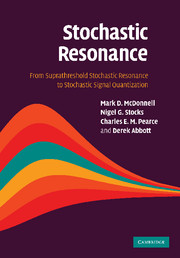Book contents
- Frontmatter
- Contents
- List of figures
- List of tables
- Preface
- Foreword
- Acknowledgments
- 1 Introduction and motivation
- 2 Stochastic resonance: its definition, history, and debates
- 3 Stochastic quantization
- 4 Suprathreshold stochastic resonance: encoding
- 5 Suprathreshold stochastic resonance: large N encoding
- 6 Suprathreshold stochastic resonance: decoding
- 7 Suprathreshold stochastic resonance: large N decoding
- 8 Optimal stochastic quantization
- 9 SSR, neural coding, and performance tradeoffs
- 10 Stochastic resonance in the auditory system
- 11 The future of stochastic resonance and suprathreshold stochastic resonance
- Appendix 1 Suprathreshold stochastic resonance
- Appendix 2 Large N suprathreshold stochastic resonance
- Appendix 3 Suprathreshold stochastic resonance decoding
- References
- List of abbreviations
- Index
- Biographies
9 - SSR, neural coding, and performance tradeoffs
Published online by Cambridge University Press: 23 October 2009
- Frontmatter
- Contents
- List of figures
- List of tables
- Preface
- Foreword
- Acknowledgments
- 1 Introduction and motivation
- 2 Stochastic resonance: its definition, history, and debates
- 3 Stochastic quantization
- 4 Suprathreshold stochastic resonance: encoding
- 5 Suprathreshold stochastic resonance: large N encoding
- 6 Suprathreshold stochastic resonance: decoding
- 7 Suprathreshold stochastic resonance: large N decoding
- 8 Optimal stochastic quantization
- 9 SSR, neural coding, and performance tradeoffs
- 10 Stochastic resonance in the auditory system
- 11 The future of stochastic resonance and suprathreshold stochastic resonance
- Appendix 1 Suprathreshold stochastic resonance
- Appendix 2 Large N suprathreshold stochastic resonance
- Appendix 3 Suprathreshold stochastic resonance decoding
- References
- List of abbreviations
- Index
- Biographies
Summary
Engineered systems usually require finding the right tradeoff between cost and performance. Communications systems are no exception, and much theoretical work has been undertaken to find the limits of achievable performance for the transmission of information. For example, Shannon's celebrated channel capacity formula and coding theorems say that there is an upper limit on the average amount of information that can be transmitted in a channel for error-free communication. This limit can be increased if the power of the signal is increased, or the bandwidth in the channel is increased. However, nothing comes for free, and increasing either power or bandwidth can be expensive; hence there is a tradeoff between cost and performance in such a communications system – performance (measured by bit rates) can be increased by increasing the cost (power or bandwidth). This chapter discusses several problems related to the tradeoff between cost and performance in the SSR model. We are interested in the SSR model as a channel model, from an energy efficient neural coding point of view, as well as the lossy source coding model, where there is a tradeoff between rate and distortion.
Introduction
Chapter 8 introduces an extension to the suprathreshold stochastic resonance (SSR) model by allowing all thresholds to vary independently, instead of all having the same value. This chapter further extends the SSR model by introducing an energy constraint into the optimal stochastic quantization problem. We also examine the tradeoff between rate and distortion, when the SSR model is considered as a stochastic quantizer.
Information
- Type
- Chapter
- Information
- Stochastic ResonanceFrom Suprathreshold Stochastic Resonance to Stochastic Signal Quantization, pp. 291 - 322Publisher: Cambridge University PressPrint publication year: 2008
